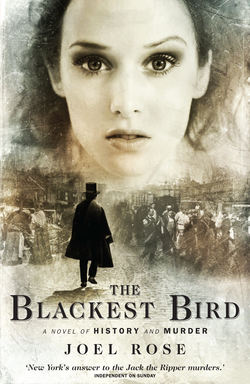Читать книгу The Blackest Bird - Joel Rose - Страница 21
На сайте Литреса книга снята с продажи.
Оглавление9
In a Clearing
A week later, in the tepid middle days of September, word reached Hays that Mrs. Loss had come forward to Bennett at the Herald with a remarkable revelation.
Her two younger sons, she recounted, Oscar and Ossian, aged nine and twelve respectively (Charlie was the eldest at fifteen), had been playing in the woods near her home, north of the old Weehawken ferry dock. In a clearing they had come across a variety of discarded clothes, gloves, handkerchief, and parasol, the lot of it inhabited by crawling bugs of the type that fester in wet discarded articles.
These found articles themselves were much mildewed and moldy, trampled down, she said, in a thicket near a cove in the woods. The parasol and handkerchief had the initials MCR embroidered on them, leaving no doubt to whom they belonged.
Hays traveled immediately to Mrs. Loss. The clothing, the parasol, the gloves, alleging to be Mary Rogers’, were all laid out in the downstairs bar at Nick Moore’s House.
“Why, my good woman, were these articles not left in place?” Hays demanded upon viewing them exhibited in this manner.
Mrs. Loss shrank back from his anger, and said in her defense she was fearful someone not connected to the case would find them and remove them.
“Not likely, considering they have remained undisturbed and unnoticed for such a period, and only now have been found,” Hays fumed, gauging the woman and her intent. Was it stupidity or slyness? “Madam, the placement of the articles in the clearing might have given me clues to how the murder was committed,” he explained slowly.
Mrs. Loss apologized profusely. “I did not realize the severity of my action, and the actions of my boys. I can only hope and pray our thoughtlessness will not impede your investigation further, High Constable. If it would be any help at all, I would not mind in the least to help you reconstruct their placement,” she offered.
The purported scene of the crime proved to be a curious, if convenient, alcove in the woods. The area was furnished with three large rocks, one of which formed a sort of seat, while a second formed a makeshift backrest, and the third a footrest or ottoman. The clearing was heavily surrounded by dense brush.
As Mrs. Loss said, every last article had been collected and removed by her and her boys. Not a shred left. Hays had only Mrs. Loss’s word for where they had been found and under what circumstances (“Here was discovered a strip of torn dress, thrice impaled on a single thorn”). The area was much trampled upon, attesting to what might have been sign of a colossal life-and-death struggle. There were indications leading from the clearing to the river that something of weight had been dragged.
The following day, September 17, 1841, a steel-point etching appeared on the front page of the New York Herald depicting the Nick Moore House, its clapboard siding, the wooden stairs and rail going up, the single dormer in the center of the shingled roof.
Beneath, in large bold type, was printed the legend:
THE LAST PLACE ON EARTH
WHERE MARY ROGERS WAS SEEN ALIVE
Opposite, also on the front page, a poem inscribed “To Mary,” credited to the city’s laureate poet and signed “Fitz-Greene Halleck,” took residence in the lefthand column.
Mary had been noticed at some public places
(The Battery and Broadway)
For hers was one of those glorious faces,
That when you gaze upon them, never fail,
To bid you look again; There was a beam,
A lustre in her eye, that oft would seem
A little like effrontery; and yet
The lady meant no harm; her only aim
Was to be admired by all she met,
And the free homage of the heart to claim;
And if she showed too plainly this intention,
Others have done the same—’twas not of her
invention.
But where is Mary? She has long been thrown
Where cheeks and rose wither—in the shade.
And although, as I once before have said,
I love a pretty face to adoration,
Yet, still, I must preserve my reputation.
